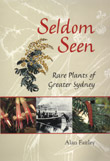|
[Front Page] [Features] [Departments] [Society Home] [Subscribe]

A Good Read
.....what's worth a look?
Reviews in this issue cover Seldom Seen: Rare Plants of Greater Sydney by Alan Fairley, Melaleucas: A Field and Garden Guide by Ivan Holliday and Australian plants for Mediterranean climate gardens by Rodger Elliot. |
 |

 
Seldom Seen: Rare Plants of Greater Sydney
Alan Fairley
Published by New Holland Publishers.
256 pages, colour photographs, paperback.
$A29.95
Reviewed by Cas Liber
 
Seldom Seen is the latest book by Alan Fairley, co-author of Native Plants of the Sydney District and describes 210 rare plants of the greater Sydney basin. Alan had originally intended it as more of a key but the book evolved into a more of a narrative text as many of the plants have interesting stories and people behind them - species discovered by chance (Hakea dohertyi), others extremely rare (Hibbertia superans), recent rediscoveries (Asterolasia buxifolia), and yet others with more complex tales - such as Grevillea rosmarinifolia and the quest for its Type form, feared (until recently) to be extinct in the wild.
The book is easy and interesting to read and the stories are fascinating. Overall, this is a valuable addition to those interested in plants native to the Sydney region. Many plants within the book have precious little published information (especially photos) on them elsewhere. Each plant has at least one colour photo accompanying it. My only complaint is that I wish the photos, while excellent, could have been a little larger. However I realise the size would have been limited by the size of the book.
I hope this inspires a new generation of explorers, conservers and even cultivators of our local Sydney flora.

 
Melaleucas: A Field and Garden Guide
Ivan Holliday
Published by Reed New Holland, Sydney, 2004.
Colour photographs, line drawings, paperback, 328 pages.
$A36.95.
Reviewed by R. D. McKinnon AM Curator, Brisbane Botanic Gardens
 
I do so admire Australian plant authors who, often with limited financial resources and in retirement write, illustrate and photograph seminal works that further our understanding of our own Australian native flora.
Such a book has just been published: "Melaleucas: A Field and Garden Guide" by my good friend of 35+ years, South Australian author, Ivan Holliday OAM.
Known internationally as one of the early Australian native plant enthusiasts, his writings in tandem with my Plant Identification Lecturer, the late Ron Hill, were some of the earliest photographic and descriptive field guides of Australian native plants, while his book: "Growing Australian Plants" with retired Director of the Adelaide Botanic Garden, Noel Lothian OBE, is still highly regarded as a trail blazer in the native plant book genre.
Why haven't we used more melaleucas in our gardens? They used to form the framework of every self respecting 'native' garden! Many are hardy and adaptable, and there are species for every situation. They come in many shapes and sizes and their spectacular flowers display an array of vibrant colours.
A member of the very large family Myrtaceae, the genus Melaleuca is widespread in Australia, from the tropical north where paperbark swamps are common, through the arid inland, often in sandy or gravelly soils, to the wet, cold coastal areas of western Tasmania. Whilst Australia is the home of most Melaleuca species, a few tropical ones extend beyond Australia to the north, where they are found in places such as New Guinea, New Caledonia and Malesia. It was in fact from one of these species found outside Australia that the generic name was derived.
The genus was founded in the eighteenth century by Carolus Linnaeus and named from the Greek melas, meaning black, and leucos, white, apparently because of the tree's black trunk (probably charred by fire) and white-barked upper branches.
A team lead by Lyn Craven of the National Herbarium, CSIRO, Canberra, has recently revised the genus, describing 255 species in Australia, some of which extend to Malesia and New Caledonia. M.howeana, from Australia's Lord Howe Island, is not included in this revision nor in this book. There are seven other species which occur only in New Caledonia.
The 255 species described for Australia, however, include 36 species which are currently Callistemon, and because this change has not yet been published or accepted, these 36 species have been omitted from this new edition. Furthermore, the revision team is examining some plants now under the M.uncinata umbrella, a study expected to add more species, three being included here (M.concreta, M.hamata and M.osullivanii).
This book then includes the 219 described Melaleuca species, the three named above in the M.uncinata study, 16 subspecies, 5 varieties and 10 garden forms and un-named species, a total of 253 different melaleucas. It totally revises and combines relevant information which was published in Ivan's earlier books on melaleucas.
Ivan Holliday's first book on melaleucas - or paperbarks - was published in 1989. It was reprinted in 1996 and he later published a smaller second volume to keep readers up to date with rearrangements and name changes within this group. Only now does this book bring all melaleucas together in one volume.
Like so many authors, Ivan writes: "Ross, I am hoping that you can assist - by helping, wherever possible, to publicise this book. My reason is not related to my own financial returns - in fact, I accepted the worst possible scenario for royalties just so the book could be published - after all of my research I wanted to see it in print and have little interest in the financial aspect."
"My reason is that the publisher, New Holland, have advised that unless 'Melaleucas' sells well and reasonably rapidly, they would be unlikely to proceed with any more specialised books - eg 'Hakeas: A Field and Garden Guide', which I am currently working on and which also will cover all named species at this time".
By the way, I seem to remember a similar publishing scenario with the late Keith Williams OAM Volume 4 "Native Plants - Queensland". Was it not SGAP and a shove from the Brisbane Botanic Gardens that saw the last in Keith's four volume set a reality?
These books are the very building blocks of future literary endeavours and will greatly advance our knowledge of Australian plants.
"Melaleucas: A Field and Garden Guide" comes very highly recommended.
Reproduced from the Bulletin, newsletter of the Society for Growing Australian Plants (Queensland), June 2004.

 
Australian plants for Mediterranean climate gardens
Rodger Elliot
Published by Rosenberg Publishing Pty Ltd, 2003.
Soft cover, 144 pages, colour illustrations.
$A24.95
Reviewed by Tony Cavanagh
 
Rodger Elliot needs no introduction to gardeners and growers of Australian plants.
In writing about Australian plants, Rodger is indulging in a major passion (or as he freely admits in the acknowledgements, an "addiction"), but once again he has produced a wonderfully concise yet immensely informative book which introduces us to over 100 "very choice plants". With perhaps over 16,000 Australian plants from which to choose, selecting just 100 is obviously extremely difficult, requiring, in Rodger's own words, "disciplined selection and many hard decisions". I was delighted to see that nearly all of the species chosen were plants that I was familiar with and which I regard as fairly reliable garden plants. Thus, the information the book contains is excellent for those just starting out on or rejuvenating an Australian garden.
The preface, which users are advised to read, explains what the book is about. I can do no better than to quote from it: "The introduction provides background information on the Australian landscape, including its past history and its present fantastic plant life, as well as Mediterranean regions of the country. There is basic information on container plants, pruning and shaping of plants, watering, fertilising, mulching, propagation, pests and diseases. The aspect of weeds and their relevance to gardeners is discussed as they are now of global importance. Under the various headings of Groundcovers, Tufting Plants, Climbers, Shrubs and Trees, over 100 very choice plants are described. Cultivation and propagation is provided for each plant, together with suggestions for plant groupings under the heading "Picture Making". In the Picture Making section, only plants included in this book are mentioned".
It is obvious that many other plants could have been included, especially for the combinations, but those discussed are a good starting point and growers are advised to explore further. Many of the species are illustrated with excellent colour photographs. Some photographic examples of the "Picture Making" combinations are given but I would like to have seen more - I daresay that costs have prevented this. The book concludes with a Quick Reference Plant Selection Guide, an extensive list of further reading, a glossary including the origins or meanings of plant names and an index. Both the Guide and the index are tied to the page or section where the species is described and its use in Picture Making. The Guide is especially useful as it lists plants suitable for a range of soil types or climatic conditions, plants with specific attributes such as excellent floral displays, those for specific uses such as hedge plants, and those for attracting wildlife.
I found the text very easy to read, with clearly presented cultivation information which arises from Rodger Elliot's lifelong love of and association with Australian plants. Such detailed, practical information is often hard to find in other sources and ties the plant's requirements in its natural environment with how it should be treated in cultivation. Thus in discussing Kennedia coccinea, he states "The species is from southern Western Australia where it occurs as an understorey plant in the tall eucalyptus forests, often growing in association with other colourful spring plants. In cultivation, the Coral Vine likes well-drained soils and the protection of other plants to give a semi-shaded root area. It can be extremely quick growing and will flower from an early age but plants are not always long lived. Small pods containing seeds which can be used to propagate plants for use when older plants need replacement follow the pods". Rodger contends that "we need to know the specific requirements of each and every plant we wish to grow in our gardens if we hope to gain the best results", and this book goes a long way to providing this information.
I have only one query. I may have missed it, but nowhere could I find a definition of "truly Mediterranean climate". Perhaps for a second edition? I was also a little surprised to see that the only area of Victoria that qualified was the far north-west - I was under the obviously mistaken impression that a lot more of Victoria could be described as Mediterranean. I also wonder whether "Picture Making" is the best term for the suggested plant groupings - is "Attractive flowering combinations" any better? These minor points aside, I was very taken with the whole concept of this book and with the amount of practical information it contains. To me, it is one of those books that all growers should have.
Highly recommended.
Reproduced from Growing Australian, newsletter of the Australian Plants Society (Victoria), March 2004.

[Front Page] [Features] [Departments] [Society Home] [Subscribe]
Australian Plants online - June 2004
Association of Societies for Growing Australian Plants
|